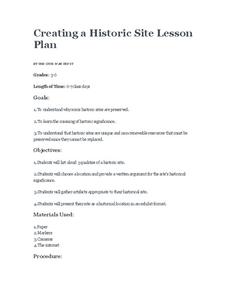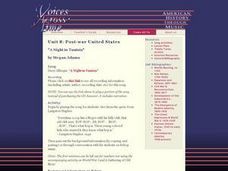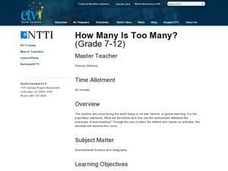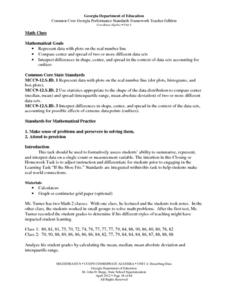Mathematics Vision Project
Quadratic Functions
Inquiry-based learning and investigations form the basis of a deep understanding of quadratic functions in a very thorough unit plan. Learners develop recursive and closed methods for representing real-life situations, then apply these...
Civil War Trust
Creating a Historic Site
A historic site marks a place where a relevant historical event occurred, no matter how many people know about it. Small groups choose their own historical sites, including a place where a class member was born, or even a football field...
K5 Learning
Here Is A Nest
Answer the what, the how, and the why in a reading passage about a hen and her chicks. Readers use the text as a basis for finding the exact answers within the passage.
Heritage Foundation
The Purpose of the Constitution
What does the Constitution have to do with my life? This is a question teachers hear on a day-to-day basis. Teach high schoolers just how relevant the US Constitution is to them today with essays, real-life connection activities, and more.
Learning Games Lab
Bacteria Sampling
Scholars explore the procedure for bacteria sampling in a virtual lab by first walking through a detailed step-by-step procedure of preparing the samples of raw milk and pasteurized milk, growing the bacteria, and comparing results....
Curated OER
Shopping
Young scholars determine how much money they have in hand, find and read the price of a product, determine which product to buy, determine if they have enough money, and count out exact change or determine how much change is due.
Curated OER
A Night in Tunisia
Young scholars discuss musical instruments common to jazz and compare several songs by various artists. They identify musical grooves common to jazz music. They compare a string quartet to a traditional jazz group.
Curated OER
How Many Is Too Many?
Students explore the population explosion. They view a video depicting the exponential growth of human population. Students research the internet to project future population data. They perform hands-on, multimedia activities to study...
Baylor College
Your Energy Needs (BMR)
How many Calories one needs on a daily basis is dependent on a number of factors including gender, height, and activity level. In the third of seven lessons about energy and food, young nutritionists calculate the number of Calories...
Council for Economic Education
How Neolithic Farmers Increased Their Standard of Living
How do people improve their economic situations? While many learners may not consider questions about how many crops to grow in ancient times were economic decisions, a hands-on activity encourages individuals to make these connections....
Curated OER
Cloze Reading: The House on Mango Street
An advocate of cloze reading? “Marin”, a chapter from Sandra Cisneros’ The House on Mango Street, is used as the basis of a cloze reading exercise. An answer sheet is provided.
Pennsylvania Department of Education
Problem Solving by Using Multiplication to Solve Division Problems
Students use index cards, counting cubes, and their own understanding to identify how division problems can be solved by using multiplication. In this division lesson plan, students use their multiplication skills to solve division...
3C Skills Collaborative
Skill 10: Present to Groups
After a brief class discussion about public speaking, individuals complete a handout that asks them to reflect on the best and worst presentations they've seen. The extension activity involves students presenting to the class on a...
Curated OER
Feelin; a Groove
Students compare and contrast two versions of April in Paris. They discuss the songs in terms of the grooves each one captures and identify the instruments responsible for creating them.
Curated OER
Lakota Numbers
Students count in Lakota Sioux numbers and solve math problems. In this algebra lesson, students count in a different language and use it to solve math problems. They work on their pronunciation and spelling as well as math skills in...
Curated OER
Watermelon Graphing
Students discover bar graphs. For this primary math lesson plan, students identify the parts of watermelon seeds and other seeds. Students learn the proper names and common names which refer to the parts of the seeds as they create a bar...
Curated OER
Too Much of a Sweet Thing
Students examine the growing prevalence of processed sugar in the American diet, first through a demonstration that makes graphically clear the amount of sugar an average boy and girl consumes on a daily basis.
Curated OER
Add It Up
First graders engage in a lesson plan that gives the research basis for the use of manipulatives for the basic operations in mathematics. They use the variety of tools to solve basic problems. The lesson plan has valuable resource links...
Curated OER
Comparing Apples and Onions
Fifth graders observe and compare apples. In this apples lesson, 5th graders work in groups to record the physical characteristics of a variety of apples. Students predict each apples weight and then weigh them to see if they were...
Curated OER
Dealing with Data in Elementary School
Students follow the scientific method in collecting data. In this following the scientific method in collecting data lesson, students develop a question they would like answered such as how many aluminum cans are consumed each school...
Curated OER
ESL: Practice Using Present Progressive Tense
Small, cartoonish pictures of people expressing emotions and actions (blowing his nose, holding her head and frowning, dancing, smiling) provide the basis for writers to describe the feelings and experiences taking place. Help your ESL...
Georgia Department of Education
Math Class
Young analysts use real (provided) data from a class's test scores to practice using statistical tools. Not only do learners calculate measures of center and spread (including mean, median, deviation, and IQ range), but also use this...
Illustrative Mathematics
How Thick Is a Soda Can I?
The humble soda can gets the geometric treatment in an activity that links math and science calculations. After a few basic assumptions are made and discussed, surface area calculations combine with density information to develop an...
EngageNY
Finding a Rate by Dividing Two Quantities
Develop the right station to solve rate word problems. The 18th lesson in a series of 29 starts by interpreting the aspects of rates with two different quantities. Pupils use the interpretation of rates to solve problems, and groups work...

























